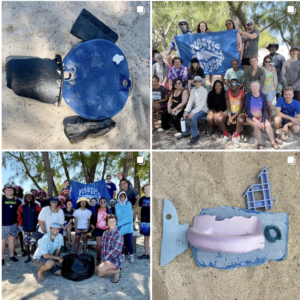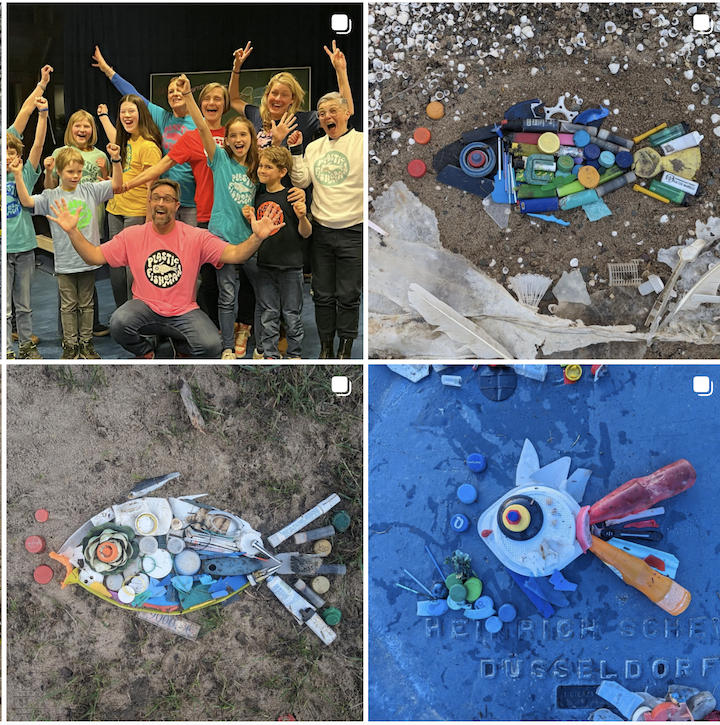By Deniz Vural, ESRAG Director
The Earth’s vast oceans, constituting about 70% of the planet’s surface, contain approximately 97% of its water, with the remaining 3% found in various forms such as glaciers, ice, underground reservoirs, rivers, and lakes. This distribution emphasizes the scarcity of freshwater, making up less than 3% of Earth’s total water. Beyond its role in sustaining life, the oceans serve as a dynamic force in the global water cycle, connecting Earth’s water resources through intricate processes.
Regrettably, this fragile system faces a grave threat from the escalating global crisis of plastic pollution. The United Nations Environmental Programme (UNEP) reports that each day an amount equivalent to 2,000 garbage trucks laden with plastic finds its way into the world’s oceans, rivers, and lakes. This is comparable to tipping a dustbin lorry into the ocean every minute. Approximately 13 million tonnes of plastic enter the ocean yearly. Comprising 80% of litter items globally, plastic pollution, particularly from single-use takeout food and beverage containers (50–88%), has significantly increased over the past decade.

Education and social potential of Plastic Fisherman.
Acknowledging the critical importance of ocean literacy, you can draw on the resources of Plastic Fisherman, a global educational project committed to raising awareness about the perils of marine plastic pollution. Their mission is to inspire action through the potent combination of creativity, art, positivity, and community engagement. Your Club or District can use its strategies to communicate effectively about the ocean and equip your community to make informed, responsible decisions to protect ocean resources, grounded in knowledge about the vital ecological services the oceans provide.
“Plastic Fisherman primarily focuses on awareness and education, promoting upstream solutions and adopting a proactive stance,” says Rodrigo Butori, founder of Plastic Fishermen. “We are a true grassroots movement born out of my passion for the ocean and a desire to give back. We have no links or financial connections to any industry, public or private organizations.”
“Our Instagram posts, Plastic Fishing Festivals, and Litter At Sea lesson plans are designed to raise awareness about marine plastic pollution and educate on the general impact of plastics and the ways we can mitigate it. These proactive measures emphasize the importance of preventing plastic waste creation, promoting a forward-thinking culture that anticipates problems and fosters a sustainable mindset. This approach aims to transform our perception of plastics and our relationship with the material.”
Plastic Fisherman is active in ten countries: Brazil, Bahamas, Germany, Mauritius, Japan, Spain, UK, Uruguay, Denmark and USA. Click on a country’s link to engage with their Instagram account. In essence, Plastic Fisherman engages in three core activities:
Inspire:
Harnessing the visual appeal and immediacy of social media, they have turned beach/local cleanups into a playful, inclusive, and easily accessible activity they named ‘plastic fishing.’ Anyone, anywhere, at any time can participate by following these simple steps:
- Collect five or more pieces of plastic from your beach or community.
- Craft a small fish from the collected plastic.
- Capture a photo of your creation.
- Share it on Instagram using #plasticfishing or tagging @plasticfisherman.
- Dispose of the plastic responsibly in recycling bins.
This approach has cultivated a global community with over 26,000 participants from 94 countries, collectively removing an estimated 30,000 pounds of trash and plastic residue.
Educate:
Plastic Fisherman organizes educational events, including the Plastic Fishing Festival, providing a platform for partner sponsors to align with environmental, social, and governance (ESG) goals. This initiative enhances sustainability messages, gaining exposure to a global audience through posts and stories on multiple Instagram accounts. More than 60 events have been organized in six different countries, involving thousands of participants.
Transform:
Rather than concluding the Plastic Fisherman community clean-up, they initiate a new phase through the Plastic Fisherman Workshop. This hands-on circularity lab integrates art, design, creativity, and plastic recycling techniques. Dedicated to the research and development of products using single-use LDPE, HDPE, and PP thermoplastics collected from local beaches and communities, this workshop embodies a unique educational space.
“The principles of Refuse, Reduce, Reuse, Repurpose should be ingrained in everyone’s minds, highlighting how individual and community actions can influence demand for more sustainable products/packaging, shape policy, and continue to spread awareness,” says Rodrigo Butori. “Additionally, we aim to redefine the concept of ‘Cost’ in the context of a plastic product’s entire lifecycle. Moving beyond traditional economic metrics, we consider the hidden environmental, social, and long-term economic impacts of plastics, from extraction and manufacturing to disposal.”

Plastic Fisherman Bahamas.
“While crucial to the circular economy, recycling is not the sole solution to plastic pollution due to low global rates, logistical challenges, high cost of the process, and the ongoing production of virgin plastics. Indeed, it’s vital to ‘turn off the faucet,'” he adds. “Yet, as estimated by the UNEP, we can’t ignore the 9 billion tons of plastic already in the world. It is crucial to invest in and develop new and broader recycling technologies capable of handling all types of plastics, creating a global recycling standard, and enhancing materials’ collection, sorting, and processing. Extended producer responsibility and, in my view, taxing virgin plastics to finance the process and equalize the market value between recycled and virgin materials are essential,” he explains, for recycling to reach its potential as part of the solution.
“Currently, recycled plastic is significantly more expensive than virgin plastic, and that’s the trap the plastics industry puts us in. There’s a solution, but it’s unfeasible economically and logistically complicated, leading to the reality that only about 9% of global plastics have been recycled. It’s inaccurate to claim that ‘recycling doesn’t work.‘ As a process, it does work. It is effective, using 66% less energy compared to producing new plastic from scratch. HDPE, LDPE, and PP plastics can be recycled multiple times for packaging, or downcycled for other products if their polymer properties degrade.”
“Once again, recycling is a key element of a circular economy. There’s no need to produce more plastic; imagine the possibilities with what we already have.”
If we don’t act, by 2050 there could be more plastic than fish in the sea: With a database that is regularly updated, the interactive online portal Litterbase provides stakeholders and the general public access to our current state of understanding of marine litter and microplastics and their impact on marine life.
Plastic pollution has infiltrated every corner of the ocean, extending from the sea surface to the deep ocean floor, and spanning the planet from the poles to the coastlines of the most secluded islands. Its presence is evident in the smallest plankton to the largest whales. Additionally, rising plastic pollution holds the potential to alter habitats and disrupt natural processes, diminishing the adaptability of ecosystems to climate change. It adds to the range of existing human-induced pressures on the ocean, including global warming, ocean acidification, deoxygenation, overharvesting, bycatch, shipping and underwater noise, habitat destruction, and chemical pollution.

Plastic Fish in Japan.
The cumulative impact of these stressors may, over time, push vulnerable marine species, populations, or ecosystems in heavily polluted areas beyond their threshold, potentially resulting in detrimental effects on the affected ecosystems and their services, as this World Wildlife Fund report documents.
This also directly affects the livelihoods of millions of individuals, impacting food production capabilities and overall societal well-being. When evaluating the ecological toll of plastic pollution, the cumulative impact becomes even more staggering, with an annual influx of 19-23 million tonnes of plastic waste infiltrating aquatic ecosystems, and contaminating lakes, rivers, and seas. Should this trajectory persist, by 2050 there could be more plastic than fish in the sea.
Once introduced into the oceans, plastics exhibit uneven distribution across marine regions, species, and ecosystems. While a few areas remain relatively untouched by plastic pollution, most regions experience varying degrees of contamination, with specific hotspots, such as the five major ocean gyre systems and areas near significant sources like polluted rivers displaying severe pollution. Additionally, ecosystems like coral reefs, mangrove forests, and deep-sea canyons are particularly vulnerable to plastic accumulation. Certain regions, including parts of the Mediterranean, East China Sea, and Yellow Sea, are identified as pollution hotspots.
As stewards of our planet, we face a choice: to bring forth 8 billion problems or 8 billion solutions. Join the global community of plastic fishermen and women united by one belief: The ocean is for fish, not plastic.
Follow Plastic Fisherman on Instagram and YouTube and learn more by visiting plasticfisherman.com.
ESRAG Director Deniz Vural is a researcher at the Alfred Wegener Institute in Germany, where she focuses on changing shoreface dynamics in the western Canadian Arctic. As an enthusiastic climate ambassador, she pursues science communication initiatives to enhance public awareness of climate change and polar-related topics. Deniz is currently a member of two districts: RAC Tuzla (D-2420) and RC Eurasia (D-2420) in Istanbul, Turkey, and RAC Berlin International (D-1940) in Berlin, Germany.

